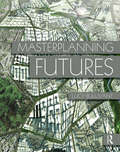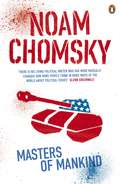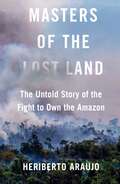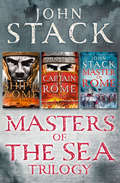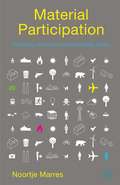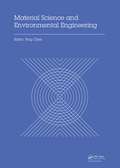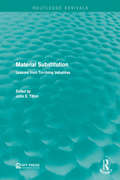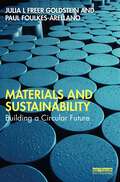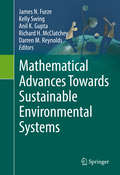- Table View
- List View
Mastermind: Mental training for climbers
by Jerry Moffatt‘The brain is the most important muscle for climbing.’ – Wolfgang GüllichMastermind by climbing legend Jerry Moffatt is a guide to mental training for climbers. Drawing on his own personal experiences, as well as inspiring stories from the current elite of the sport including Alex Megos, Adam Ondra, Alex Honnold and Barbara Zangerl, Jerry invites climbers and other sportspeople to explore and maximise their mental potential.Broken down into easy-to-read sections, including Mind Control, Self Image and Visualisation, Mastermind will help you utilise the power of your mind to make the most of your existing strength, technique and ability so that you can perform under pressure – not just in climbing, but in all sport.
Masterplanning Futures
by Lucy BullivantWinner of the Urban Design Group's 2014 Book of the Year Award! In the past, spatial masterplans for cities have been fixed blueprints realized as physical form through conventional top down processes. These frequently disregarded existing social and cultural structures, while the old modernist planning model zoned space for home and work. At a time of urban growth, these models are now being replaced by more adaptable, mixed use plans dealing holistically with the physical, social and economic revival of districts, cities and regions. Through today’s public participative approaches and using technologically enabled tools, contemporary masterplanning instruments embody fresh principles, giving cities a greater resilience and capacity for social integration and change in the future. Lucy Bullivant analyses the ideals and processes of international masterplans, and their role in the evolution of many different types of urban contexts in both the developed and developing world. Among the book’s key themes are landscape-driven schemes, social equity through the reevaluation of spatial planning, and the evolution of strategies responding to a range of ecological issues and the demands of social growth. Drawing on first-hand accounts and illustrated throughout with colour photographs, plans and visualizations, the book includes twenty essays introduced by an extensive overview of the field and its objectives. These investigate plans including one-north Singapore, Masdar City in Abu Dhabi, Xochimilco in Mexico City and Waterfront Seattle, illuminating their distinct yet complementary integrated strategies. This is a key book for those interested in today’s multiscalar masterplanning and conceptually advanced methodologies and principles being applied to meet the challenges and opportunities of the urbanizing world. The author's research was enabled by grants from the Commission for Architecture and the Built Environment (CABE), the SfA (the Netherlands Architecture Fund), the Danish Embassy and support from the Alfred Herrhausen Society.
Masterplanning Futures
by Lucy BullivantWinner of the Urban Design Group's 2014 Book of the Year Award! In the past, spatial masterplans for cities have been fixed blueprints realized as physical form through conventional top down processes. These frequently disregarded existing social and cultural structures, while the old modernist planning model zoned space for home and work. At a time of urban growth, these models are now being replaced by more adaptable, mixed use plans dealing holistically with the physical, social and economic revival of districts, cities and regions. Through today’s public participative approaches and using technologically enabled tools, contemporary masterplanning instruments embody fresh principles, giving cities a greater resilience and capacity for social integration and change in the future. Lucy Bullivant analyses the ideals and processes of international masterplans, and their role in the evolution of many different types of urban contexts in both the developed and developing world. Among the book’s key themes are landscape-driven schemes, social equity through the reevaluation of spatial planning, and the evolution of strategies responding to a range of ecological issues and the demands of social growth. Drawing on first-hand accounts and illustrated throughout with colour photographs, plans and visualizations, the book includes twenty essays introduced by an extensive overview of the field and its objectives. These investigate plans including one-north Singapore, Masdar City in Abu Dhabi, Xochimilco in Mexico City and Waterfront Seattle, illuminating their distinct yet complementary integrated strategies. This is a key book for those interested in today’s multiscalar masterplanning and conceptually advanced methodologies and principles being applied to meet the challenges and opportunities of the urbanizing world. The author's research was enabled by grants from the Commission for Architecture and the Built Environment (CABE), the SfA (the Netherlands Architecture Fund), the Danish Embassy and support from the Alfred Herrhausen Society.
Masters of Mankind: Essays and Lectures, 1969-2013
by Noam ChomskyIn this collection of essays from 1969-2013, many in book form for the first time, Noam Chomsky exposes the real nature of state power. With unrelenting logic, he holds the arguments of empire up to critical examination and shatters the myths of those who protect the power and privilege of the few against the interests and needs to the many.Covering subjects like 'Human Intelligence and the Environment', 'Terror, Justice and Self-Defence' and 'The Welfare-Warfare state', this is an indispensable compilation of searing insights into the state of our modern world.'Arguably the most important intellectual alive' New York Times on Noam Chomsky'Noam Chomsky is a global phenomenon . . . he may be the most widely read American voice on the planet today' NYT Book Review'Will there ever again be a public intellectual who commands the attention of so many across the planet?' New Statesman'The west's most prominent critic of US imperialism . . . the closest thing in the English-speaking world to an intellectual superstar' Guardian
Masters of the Lost Land: The Untold Story of the Fight to Own the Amazon
by Heriberto Araujo'Excellent' Kirkus Reviews'[A] deeply researched report from the front lines of the battle for the Amazon.' Publishers Weekly'A gripping true crime mystery... a must-read' Greg Grandin, Pulitzer Prize-winning author of The End of the Myth'An essential book' Joe Jackson, author of The Thief at the End of the WorldDeep in the heart of the Amazon, an entire region has lived under the control of one notorious land baron: Josélio de Barros. Josélio cut a grisly path to success: having arrived in the jungle with a shady past, he quickly made a name for himself as an invincible thug who grabbed massive tracts of public land, burned down the jungle and executed or enslaved anyone trying to stop him.Enter Dezinho, the leader of a small but robust farm workers' union fighting against land grabs, ecological destruction, and blatant human rights abuses. When Dezinho was killed in a shocking assassination, the local community held its breath. Would Josélio, whom everyone knew had ordered the hit, finally be brought to account? Or would authorities look the other way, as they had hundreds of times before?Dezinho's widow, Dona Joelma, was not about to let that happen. After his murder, she stepped into the spotlight, orchestrating a huge push to bring national media attention to the injustices in the Amazon.Set against the backdrop of Bolsonaro's devastating cuts to environmental protections, Brazil's rapidly changing place in the geopolitical spectrum, and the Amazon's crucial role in climate change, Masters of the Lost Land is both a gripping epic into one of the last wild places on Earth and an urgent illustration of how people are fighting for - and winning - justice for their futures and the environment.
Masters of the Sea Trilogy: Ship Of Rome, Captain Of Rome, Master Of Rome
by John StackThe trilogy of John Stack’s brilliant MASTERS OF THE SEA about the clash of the Roman and Carthaginian empires and the battle for sovereignty that rips up the high seas, here in a complete ebook for the first time.
Materan Contradictions: Architecture, Preservation and Politics
by Anne Parmly ToxeyShaped by encrusted layers of development spanning millennia, the southern Italian city of Matera is the ultimate palimpsest. Known as the Sassi, the majority of the ancient city is composed of thousands of structures carved into a limestone cliff and clinging to its walls. The resultant menagerie of forms possesses a surprising visual uniformity and an ineffable allure. Conversely, in the 1950s Matera also served as a crucible for Italian postwar urban and architectural theory, witnessed by the Neorealist, modernist expansion of the city that developed in aversion to the Sassi. In another about-face, the previously disparaged cave city has now been recast as a major tourist destination, UNESCO World Heritage Monument, and test subject for ideas and methods of preservation. Set within a sociopolitical and architectural history of Matera from 1950 to the present, this book analyses the contemporary effects of preservation on the city and surrounding province. More broadly, it examines the relationship between and interdependence of preservation and modernism within architectural thought. To understand inconsistencies inherent to preservation, in particular its effect of catalyzing change, the study lays bare planners' and developers' use of preservation, especially for economic goals and political will. The work asserts that preservation is not a passive, curatorial pursuit: it is a cloaked manifestation of modernism and a powerful tool often used to control economies. The study demonstrates that preservation also serves to influence societies through the shaping of memory and circulation of narratives.
Materan Contradictions: Architecture, Preservation and Politics
by Anne Parmly ToxeyShaped by encrusted layers of development spanning millennia, the southern Italian city of Matera is the ultimate palimpsest. Known as the Sassi, the majority of the ancient city is composed of thousands of structures carved into a limestone cliff and clinging to its walls. The resultant menagerie of forms possesses a surprising visual uniformity and an ineffable allure. Conversely, in the 1950s Matera also served as a crucible for Italian postwar urban and architectural theory, witnessed by the Neorealist, modernist expansion of the city that developed in aversion to the Sassi. In another about-face, the previously disparaged cave city has now been recast as a major tourist destination, UNESCO World Heritage Monument, and test subject for ideas and methods of preservation. Set within a sociopolitical and architectural history of Matera from 1950 to the present, this book analyses the contemporary effects of preservation on the city and surrounding province. More broadly, it examines the relationship between and interdependence of preservation and modernism within architectural thought. To understand inconsistencies inherent to preservation, in particular its effect of catalyzing change, the study lays bare planners' and developers' use of preservation, especially for economic goals and political will. The work asserts that preservation is not a passive, curatorial pursuit: it is a cloaked manifestation of modernism and a powerful tool often used to control economies. The study demonstrates that preservation also serves to influence societies through the shaping of memory and circulation of narratives.
Material Cycling of Wetland Soils Driven by Freeze-Thaw Effects (Springer Theses)
by Xiaofei YuFreezing and thawing of soils is a common phenomenon in the winter-cold zone. The thesis titled “Material Cycling of Wetland Soils Driven by Freeze-Thaw Effects” systematically explores the freeze-thaw effects on the accumulation and release processes of carbon and nitrogen in wetland soils, which is a good step toward the investigation of biogeochemical processes in wetlands in seasonal freeze-thaw areas. It is also developing strategies aimed at global warming effects on the accumulation and release of carbon and nitrogen in wetlands. Dr. Xiaofei Yu works at the Northeast Institute of Geography and Agroecology, Chinese Academy of Sciences, China.
Material Geographies of Household Sustainability
by Andrew Gorman-MurrayCharting new research directions, this book constructs a series of imperatives for linking culturally informed research around household sustainability with policy and planning. The household, or 'home', is a critical scale for understanding activities that connect individual behaviours and societal attitudes. The focus on the household in this collection provides a window into the sheer diversity of homemaking and maintenance activities that entail resource use. These practices have affective or emotive dimensions as well as habitual aspects. Diversity, innovation and change at the household scale is often missed in policy approaches which assume that simplistic economic motivations drive demand and this can in turn be 'managed' through regulation or market pricing. The research challenge extends beyond describing existing unsustainable economies driving resource intensive behaviour to consider realistic options for transformations in cultural practices, material relationships and, ultimately, the political economies they sit within. Without change in these systems, government initiatives to promote ecological modernisation run the risk of simply green-washing the very economies of consumption that currently drive unsustainable practices. Social and cultural change at the household level is critical to promoting sustainability at a range of wider scales.
Material Geographies of Household Sustainability
by Andrew Gorman-MurrayCharting new research directions, this book constructs a series of imperatives for linking culturally informed research around household sustainability with policy and planning. The household, or 'home', is a critical scale for understanding activities that connect individual behaviours and societal attitudes. The focus on the household in this collection provides a window into the sheer diversity of homemaking and maintenance activities that entail resource use. These practices have affective or emotive dimensions as well as habitual aspects. Diversity, innovation and change at the household scale is often missed in policy approaches which assume that simplistic economic motivations drive demand and this can in turn be 'managed' through regulation or market pricing. The research challenge extends beyond describing existing unsustainable economies driving resource intensive behaviour to consider realistic options for transformations in cultural practices, material relationships and, ultimately, the political economies they sit within. Without change in these systems, government initiatives to promote ecological modernisation run the risk of simply green-washing the very economies of consumption that currently drive unsustainable practices. Social and cultural change at the household level is critical to promoting sustainability at a range of wider scales.
Material Participation: Technology, the Environment and Everyday Publics
by N. MarresThis book develops a fresh perspective on everyday forms of engagement, one that foregrounds the role of objects, technologies and settings in democracy. Examining a range of devices, from smart meters to eco-homes, the book sets out new concepts and methods for analyzing the relations between participation, innovation and the environment.
Material Participation: Technology, the Environment and Everyday Publics
by N. MarresThis book develops a fresh perspective on everyday forms of engagement, one that foregrounds the role of objects, technologies and settings in democracy. Examining a range of devices, from smart meters to eco-homes, the book sets out new concepts and methods for analyzing the relations between participation, innovation and the environment.
Material Science and Environmental Engineering: Proceedings of the 3rd Annual 2015 International Conference on Material Science and Environmental Engineering (ICMSEE2015, Wuhan, Hubei, China, 5-6 June 2015)
by Ping ChenMaterial Science and Environmental Engineering presents novel and fundamental advances in the fields of material science and environmental engineering. Collecting the comprehensive and state-of-art in these fields, the contributions provide a broad overview of the latest research results, so that it will proof to be a valuable reference book to aca
Material Substitution: Lessons from Tin-Using Industries (Routledge Revivals)
by John E. TiltonSubstitution has long been a common remedy for materials shortages. This study, originally published in 1983, uses tin to examine how and why substitution takes place. To provide insights into the tin industry and the practice of substitution, the case studies in this title examine three tin-using industries—beverage containers, solder, and tin chemical stabilisers. Overall, the contributors to this volume raise fundamental questions concerning the techniques for both short- and long-term forecasts of materials requirements in the industrial sector. This title will be of particular interest to students of Environmental Science.
Material Substitution: Lessons from Tin-Using Industries (Routledge Revivals)
by John E. TitltonSubstitution has long been a common remedy for materials shortages. This study, originally published in 1983, uses tin to examine how and why substitution takes place. To provide insights into the tin industry and the practice of substitution, the case studies in this title examine three tin-using industries—beverage containers, solder, and tin chemical stabilisers. Overall, the contributors to this volume raise fundamental questions concerning the techniques for both short- and long-term forecasts of materials requirements in the industrial sector. This title will be of particular interest to students of Environmental Science.
Material World: A Substantial Story of Our Past and Future
by Ed ConwayTHE SUNDAY TIMES BESTSELLERTHE TIMES SCIENCE BOOK OF THE YEAR**Shortlisted for the Financial Times Business Book of the Year Award**Picked as a Book of the Year by FINANCIAL TIMES, ECONOMIST and NEW STATESMANA BBC RADIO 4 Book of the Week'A compelling narrative of the human story' TIM MARSHALL, author of Prisoners of Geography'Lively, rich and exciting... full of surprises' PETER FRANKOPAN, author of The Silk Roads_____________Sand, salt, iron, copper, oil and lithium. They built our world, and they will transform our future.These are the six most crucial substances in human history. They took us from the Dark Ages to the present day. They power our computers and phones, build our homes and offices, and create life-saving medicines. But most of us take them completely for granted.In Material World, Ed Conway travels the globe - from the sweltering depths of the deepest mine in Europe, to spotless silicon chip factories in Taiwan, to the eerie green pools where lithium originates - to uncover a secret world we rarely see. Revealing the true marvel of these substances, he follows the mind-boggling journeys, miraculous processes and little-known companies that turn the raw materials we all need into products of astonishing complexity.As we wrestle with climate change, energy crises and the threat of new global conflict, Conway shows why these substances matter more than ever before, and how the hidden battle to control them will shape our geopolitical future. This is the story of civilisation - our ambitions and glory, innovations and appetites - from a new perspective: literally from the ground up.
Materials and Sustainability: Building a Circular Future
by Julia L Goldstein Paul Foulkes-ArellanoThis book examines sustainable manufacturing, from the extraction of materials to processing, use, and disposal, and argues that significant changes in all of the above are needed for the world to progress toward a more circular economy.Materials and processing methods are usually chosen with performance as the key metric. Why has our society embraced plastics? Because they work. In most cases, they are lighter, easier to manufacture, and less expensive than the metal, wood, glass, or stone they have replaced. Why do industrial manufacturers use toxic chemicals? Because they are effective, but the unintended consequences may be severe. By learning how various materials are made and what happens when they are recycled, readers will better understand the value of materials and the challenges that manufacturers face when trying to make their facilities and products less toxic and less wasteful. The three chapters in Part I provide essential background about materials in the circular economy, chemicals, and waste. Part II delves into specific materials. It includes chapters on plastics, metals, wood and paper products, glass, and novel materials. Part III covers recycling and manufacturing processes, and Part IV delves into practical considerations, including the effect of regulations, concluding with a chapter that helps readers translate the information presented into action. Interviews with industry experts round out the chapters and offer valuable insights.Materials and Sustainability is a must-read for business professionals who are serious about making their companies as environmentally responsible as possible and for business and engineering students who want to begin their careers with practical knowledge about materials and their impacts.
Materials and Sustainability: Building a Circular Future
by Julia L Goldstein Paul Foulkes-ArellanoThis book examines sustainable manufacturing, from the extraction of materials to processing, use, and disposal, and argues that significant changes in all of the above are needed for the world to progress toward a more circular economy.Materials and processing methods are usually chosen with performance as the key metric. Why has our society embraced plastics? Because they work. In most cases, they are lighter, easier to manufacture, and less expensive than the metal, wood, glass, or stone they have replaced. Why do industrial manufacturers use toxic chemicals? Because they are effective, but the unintended consequences may be severe. By learning how various materials are made and what happens when they are recycled, readers will better understand the value of materials and the challenges that manufacturers face when trying to make their facilities and products less toxic and less wasteful. The three chapters in Part I provide essential background about materials in the circular economy, chemicals, and waste. Part II delves into specific materials. It includes chapters on plastics, metals, wood and paper products, glass, and novel materials. Part III covers recycling and manufacturing processes, and Part IV delves into practical considerations, including the effect of regulations, concluding with a chapter that helps readers translate the information presented into action. Interviews with industry experts round out the chapters and offer valuable insights.Materials and Sustainability is a must-read for business professionals who are serious about making their companies as environmentally responsible as possible and for business and engineering students who want to begin their careers with practical knowledge about materials and their impacts.
Mathematical Advances Towards Sustainable Environmental Systems
by James N. Furze Kelly Swing Anil K. Gupta Richard H. McClatchey Darren M. ReynoldsThis edited volume focuses on how we can protect our environment and enhance environmental sustainability when faced with changes and pressures imposed by our expansive needs. The volume unites multiple subject areas within sustainability, enabling the techniques and philosophy in the chapters to be applied to research areas in environmental science, plant sciences, energy, biodiversity and conservation. The chapters from expert contributors cover topics such as mathematical modelling tools used to monitor diversity of plant species, and the stability of ecosystem services such as biogeochemical cycling. Empirical research presented here also brings together mathematical developments in the important fields of robotics including kinematics, dynamics, path planning, control, vision, and swarmanoids. Through this book readers will also discover about rainfall-runoff modelling which will give them a better idea of the effects of climate change on the sustainability of water resources at the watershed scale. Modelling approaches will also be examined that maximize readers insights into the global problem of energy transition, i.e. the switch to an energy production system using renewable resources only. Collective and discrete insights are made to assist with synergy which should progress well beyond this book. Insight is also given to assist policy formations, development and implementations. The book has a strong multi-disciplinary nature at its core, and will appeal to both generalist readers and specialists in information technology, mathematics, biology, physics, chemistry and environmental sciences.
Mathematical Models and Environmental Change: Case Studies in Long Term Management (Routledge Focus on Environment and Sustainability)
by Douglas J. CrookesThis book demonstrates how mathematical models constructed in system dynamics modelling platforms, such as Vensim, can be used for long-term management of environmental change. It is divided into two sections, with the first dedicated to theory, where the theory of co-evolutionary modelling and its use in the system dynamics model platform is developed. The book takes readers through the steps in the modelling process, different validation tools applicable to these types of models and different growth specification, as well as how to curve fit using numerical methods in Vensim. Section 2 comprises of a collection of applied case studies, including fisheries, game theory and wildlife management. The book concludes with lessons from the use of co-evolutionary models for long-term natural resource management. The book will be of great interest to students and scholars of environmental economics, natural resource management, system dynamics, ecological modelling and bioeconomics.
Mathematical Models and Environmental Change: Case Studies in Long Term Management (Routledge Focus on Environment and Sustainability)
by Douglas J. CrookesThis book demonstrates how mathematical models constructed in system dynamics modelling platforms, such as Vensim, can be used for long-term management of environmental change. It is divided into two sections, with the first dedicated to theory, where the theory of co-evolutionary modelling and its use in the system dynamics model platform is developed. The book takes readers through the steps in the modelling process, different validation tools applicable to these types of models and different growth specification, as well as how to curve fit using numerical methods in Vensim. Section 2 comprises of a collection of applied case studies, including fisheries, game theory and wildlife management. The book concludes with lessons from the use of co-evolutionary models for long-term natural resource management. The book will be of great interest to students and scholars of environmental economics, natural resource management, system dynamics, ecological modelling and bioeconomics.
Mathematical Models and Methods for Planet Earth (Springer INdAM Series #6)
by Alessandra Celletti Ugo Locatelli Tommaso Ruggeri Elisabetta StricklandIn 2013 several scientific activities have been devoted to mathematical researches for the study of planet Earth. The current volume presents a selection of the highly topical issues presented at the workshop “Mathematical Models and Methods for Planet Earth”, held in Roma (Italy), in May 2013. The fields of interest span from impacts of dangerous asteroids to the safeguard from space debris, from climatic changes to monitoring geological events, from the study of tumor growth to sociological problems. In all these fields the mathematical studies play a relevant role as a tool for the analysis of specific topics and as an ingredient of multidisciplinary problems. To investigate these problems we will see many different mathematical tools at work: just to mention some, stochastic processes, PDE, normal forms, chaos theory.
Mathematical Models of Plant-Herbivore Interactions (Chapman & Hall/CRC Mathematical and Computational Biology)
by Zhilan Feng Donald DeAngelisMathematical Models of Plant-Herbivore Interactions addresses mathematical models in the study of practical questions in ecology, particularly factors that affect herbivory, including plant defense, herbivore natural enemies, and adaptive herbivory, as well as the effects of these on plant community dynamics. The result of extensive research on the use of mathematical modeling to investigate the effects of plant defenses on plant-herbivore dynamics, this book describes a toxin-determined functional response model (TDFRM) that helps explains field observations of these interactions. This book is intended for graduate students and researchers interested in mathematical biology and ecology.
Mathematical Models of Plant-Herbivore Interactions (Chapman & Hall/CRC Mathematical and Computational Biology)
by Zhilan Feng Donald DeAngelisMathematical Models of Plant-Herbivore Interactions addresses mathematical models in the study of practical questions in ecology, particularly factors that affect herbivory, including plant defense, herbivore natural enemies, and adaptive herbivory, as well as the effects of these on plant community dynamics. The result of extensive research on the use of mathematical modeling to investigate the effects of plant defenses on plant-herbivore dynamics, this book describes a toxin-determined functional response model (TDFRM) that helps explains field observations of these interactions. This book is intended for graduate students and researchers interested in mathematical biology and ecology.

